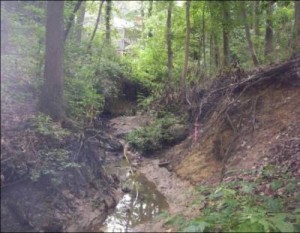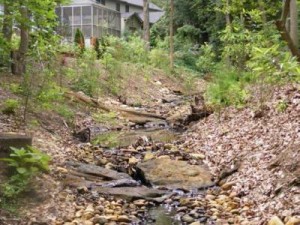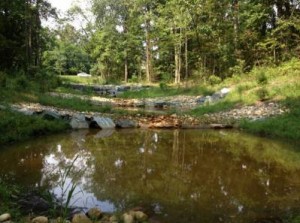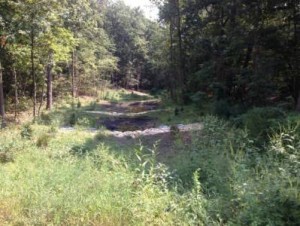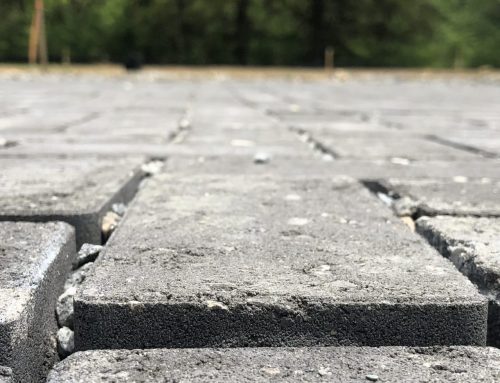After working with the Center for Watershed Protection (the Center) for almost eight years, I recently took a position back in June as a program manager for Anne Arundel County’s Watershed Protection and Restoration Program (WPRP). I really enjoyed my time at the Center, and after working with many local governments on watershed and stormwater projects, I wanted to experience local government life first-hand. What better a place than the County I have lived in most of my life!
At the Center, I wore many hats, one of which was helping to conduct stormwater retrofit assessments. Retrofits help restore watersheds by providing stormwater treatment in locations where practices previously did not exist or were ineffective. They’ve become an attractive way for local governments to meet their permit and TMDL requirements. In my experience working with local governments to conduct retrofit assessments, they each have varying restoration goals and objectives that drive what pollutants need to be treated, how much storage is needed, and where the most cost-effective locations are in the watershed. Some of the common objectives are to reduce pollutants of concern, meet state and federal mandates, comprehensive watershed restoration, and stormwater demonstration and education. After the objectives are established, the basic process that is followed includes a desktop retrofit analysis, retrofit reconnaissance field investigation, retrofit inventory compilation, evaluation and ranking, and subwatershed treatment analysis.
It has been interesting to compare Anne Arundel County’s progress with stormwater retrofitting to my previous experience working at the Center. The County’s main objective for stormwater retrofitting is to improve the water quality of the Chesapeake Bay and its tributaries, as outlined in its Watershed Implementation Plan and required by its NPDES MS4 permit. Additional objectives include ecosystem enhancement, improving failing or outdated infrastructure, addressing downstream erosion, avoiding additional impacts to sensitive streams/thermal loading, and creating floodplain uplift and flooding mitigation.
Priority projects are identified in the County’s Comprehensive Watershed Management Studies and Plans that are developed as part of its MS4 permit for each of the 12 County watersheds. Priority projects include:
- Stormwater Facility Retrofits – Existing facilities, such as dry ponds, detention ponds, or infiltration basins that have failed are rebuilt to optimize their pollution reduction capacity and provide an array of ecosystem benefits. This strategy generally involves retrofitting stormwater management ponds that were constructed before 2002 and that drain more than 10 acres.
- Stormwater Outfall Retrofits – Major outfalls from stormwater pipe conveyance systems and zero order ephemeral channels are retrofitted with Step Pool Storm Conveyance filtering systems (SPSCs). Priority is given to those outfalls within severely degraded and degraded subwatersheds as classified through County watershed assessments.
- Stream Restoration – Incised ephemeral and first order stream channels are restored using SPSC systems. Additionally, degraded and severely degraded perennial channels are restored using appropriate techniques to improve water quality, flooding, and provide ecological benefits.
In comparison to the Center’s retrofit process of compiling a retrofit inventory after field investigation has been conducted, the County has created its inventory using broad-brush planning techniques, similar to the desktop assessment that I am familiar with from the Center. The sheer number of potential retrofits identified limits the ability to conduct field investigations prior to the inventory compilation – over 800 outfall retrofits, 300 pond retrofits and 100 stream restoration projects have been identified to date. Instead, the County’s approach is to schedule the retrofits over the next several years as part of its Capital Improvement Program based on identified priority areas. As the timeline for a particular priority area approaches, the designer then field verifies the applicability and priority of the proposed retrofits in that area and may adjust the retrofit inventory accordingly.
Another difference I’ve noticed is the use of both public and private lands. Although my past experience with retrofitting did include some private properties, it mostly centered on public land because it does not require land acquisition and can provide community benefits. The County’s watershed assessments reveal that 64% of the land in the County is privately owned, and that stormwater exiting those properties is a major contributing factor to the impairment of waterways. The County’s Department of Public Works and the Arlington Echo Outdoor Education Center created the Watershed Stewards Academy that trains and supports Master Watershed Stewards, whose role it is to engage their communities in reducing pollution sources and employing stormwater/rainscaping retrofits. Stormwater BMPs implemented by Certified Master Watershed Stewards are tracked and accounted for by the County in calculating the County’s progress toward meeting its nutrient and sediment load reductions.
It is encouraging to see the progress that the County has been able to make due to funding from the recently implemented Watershed Protection and Restoration Fund. In the 2014 fiscal year, the number of projects initiated includes 177 pond retrofits, 39,364 linear feet of stream restoration, and 174 outfall enhancements. Descriptions of the current restoration projects can be found here. With hundreds of projects programmed over the next several years, I look forward to seeing the progress that is made in achieving the County’s water quality goals and restoring the health of our local creeks and rivers. It is especially interesting to me to see this all happening in my own backyard!
Do you have an interesting stormwater retrofit strategy in your area? Please share your experience in the comments.
Lisa Fraley-McNeal
Research Specialist
Lisa has over 10 years of experience in urban watershed and stormwater management. She originally joined the Center in 2006 and recently returned after spending the past year as a Program Manager for Anne Arundel County’s watershed Protection and Restoration Program, where she oversaw program elements related to the County’s Stormwater Remediation Fee. Her areas of expertise include GIS and field methods for watershed assessment, watershed planning, and applied research on topics related to watersheds and stormwater. She served as one of the Sediment and Stream Corridor Restoration Coordinators for the Chesapeake Bay Program and helped with the development of the Stream Restoration Expert Panel recommendations. Lisa’s interests include fluvial geomorphology, urban hydrology, and sedimentology.


